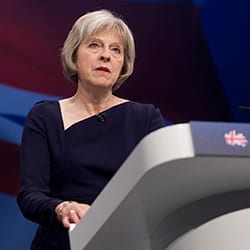The seismic shockwaves caused by the Brexit vote on June 23 continue to reverberate across the political and economic landscape in Britain but one thing, at least, has become clear. Theresa May heads to Buckingham Palace on Wednesday afternoon to “kiss hands” with the Queen – become the 13th prime minister of Elizabeth II’s reign of 64 years – and formally (and ritually) take over as prime minister from David Cameron. After returning to 10 Downing Street and writing the “letter of last resort” instructing the commanders of Britain’s nuclear submarines of their response in the event of a devastating attack on the United Kingdom that has destroyed all communication with London, Prime Minister May – who turns 60 in October – will face a daunting in-tray of immediate domestic and foreign policy challenges.
Theresa May is no stranger to the highest tier of British politics and she brings a wealth of experience that both David Cameron and Tony Blair (who had never held government jobs before they became prime minister) lacked. First elected as a member of Parliament in the year of Tony Blair’s landslide victory for the left-wing Labor Party in 1997, May became a key figure during the Conservatives’ long thirteen years in political opposition. After joining the “Shadow Cabinet” in 1999, May became party chairman in 2002 and rose to national prominence that year with a combative speech that urged the Conservatives to modernize and shed the “Nasty Party” tag it had acquired during their turbulent last years in power under Margaret Thatcher and John Major in the 1990s. The modernization theme later was embraced by a young David Cameron after he became Conservative Party leader in 2005, but it was May who had laid much of the groundwork for this three years earlier.
Since the Conservative Party returned to government in 2010, initially in coalition with the Liberal Democrats until 2015, May served as home secretary responsible for internal policy, immigration, and citizenship, and was perceived to have made a success of a notoriously difficult post that has ended the careers of numerous other politicians over the years. Although the Home Office is known as one of the “Great Offices of State” alongside the Treasury and the Foreign and Commonwealth Office, only two home secretaries since the 19th century later managed to become prime minister – Winston Churchill and James Callaghan. Moreover, sizeable gaps existed between Churchill’s and Callaghan’s time as home secretary and prime minister – three decades in Churchill’s case – and May is the first home secretary to step directly into Number 10 since the Duke of Wellington – victor over Napoleon at Waterloo – briefly held both positions simultaneously in 1834.
The largest and most immediate task for May as prime minister will be to address the many unresolved questions arising out of the nature and timing of Britain’s withdrawal from the European Union. Nearly three weeks after the political earthquake delivered by the British electorate on June 23, there is little consensus – or even understanding – of precisely how the UK will disengage from the EU or the form that a future relationship between the two will take. Very little contingency planning appeared to have been done by the government to address the ramifications of a “leave” vote and many of the leading figures in the leave campaign either have resigned or have tried to row back on some of the promises they made during the referendum. It will fall to May to trigger Article 50 that formally begins the two-year process of separation from the European Union and oversee the difficult process of negotiation with the remaining 27 member states over Britain’s future access to European markets.
Other major tasks facing Prime Minister May include minimizing the economic fallout from Brexit and choosing whether to continue Cameron’s controversial austerity campaign that arguably contributed to the success of the anti-establishment forces in the Brexit campaign, repairing social relations fractured during the divisive referendum campaign and aftermath, and reassuring Britain’s allies and partners that Brexit does not necessarily mean a retreat into isolationism, even though domestic issues will undoubtedly take priority over foreign policy in the short-term. May also must decide whether or not to call a general election to give her an electoral mandate; neither of the last two Prime Ministers to take office without an electoral mandate – John Major in 1990 and Gordon Brown in 2007 – did so, but the opposition Labor Party has gone into meltdown since the Brexit vote and appears unable to provide any meaningful political opposition for some time to come.
Finally, as Britain’s second female prime minister, May will – perhaps unfairly – be compared to Margaret Thatcher at every turn, particularly by her own Conservative Party which has elevated Thatcher to cult-like status in the quarter-century since she was forced out of power in 1990. Like May, Thatcher became prime minister at a difficult moment of political and economic turmoil following the ‘”Winter of Discontent” and waves of strikes and industrial action of 1978-79, and succeeded in reversing Britain’s long postwar decline, albeit at considerable economic and social cost. It remains to be seen whether a May premiership achieves the same, but a new chapter of British political history is about to begin.
Kristian Coates Ulrichsen is a British citizen who lived, studied and worked in Cambridge and London for 16 years prior to moving to the United States and joining the Baker Institute for Public Policy in 2013. During this period, he obtained a Ph.D. in history from Pembroke College, University of Cambridge, and worked at the London School of Economics and Political Science. He remains an Associate Fellow at the Royal Institute of International Affairs (Chatham House) in London.
